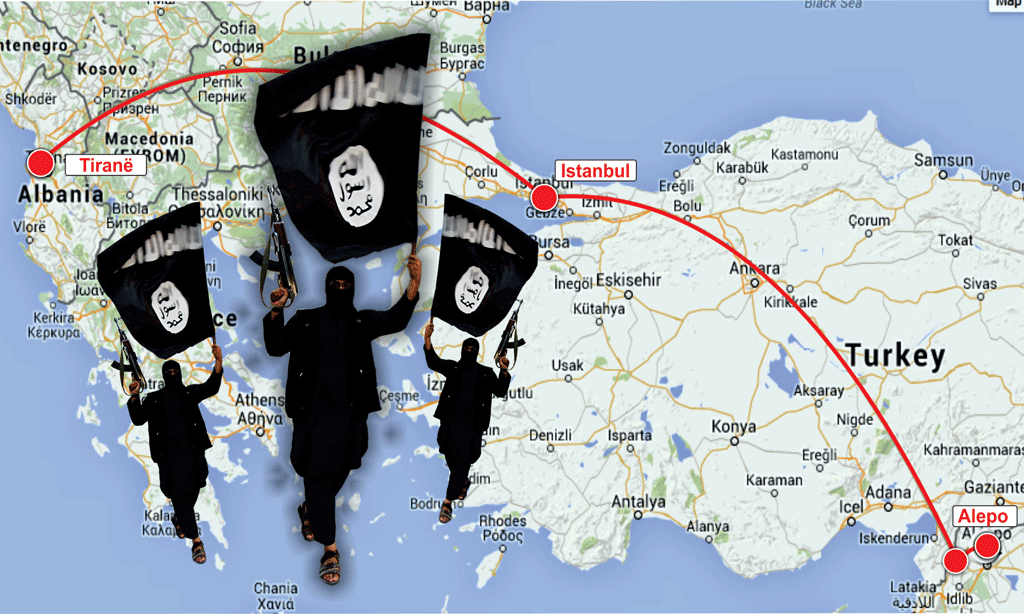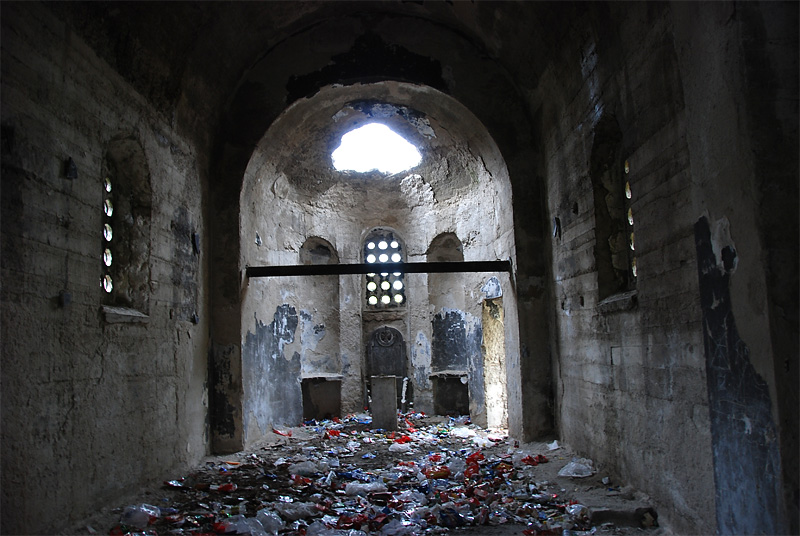
Views: 3175
Two Kosovo Albanian Muslim muhajedeens (with the passports of Republic of Kosovo) as members of ISIL in Syria in 2015 (Official ISIL’s video material)
After the 9/11, a worldwide “War on terror” begun in order to disband and neutralize Islamic terrorist networks across the globe. The main focus of the largest anti-terrorist campaign in history is focused in the Middle East area, as well as in Afghanistan.
The Balkan Peninsula is the European area where this campaign has also taken place, with numerous arrests and a continuous effort into riding the fundamentalist out of the area. The question arising though, is how did the extremists gain a foothold in South Eastern Europe in the first place, and what was the reaction of the international community over the previous years.
The presence of Islam in the Balkans dates back in the 13th century.
In order to create the much needed mercenary armies, against the then archenemy, the Francs; Byzantine Emperors allowed Muslim Turks into modern day Bulgaria. They were used mainly as cavalry forces due to their excellent techniques in that kind of war. Over the coming decades the antagonism between the Francs and the Vatican from one side and the Byzantium from the other, led to the final conquest of Constantinople by the Ottoman Turks in 1453. Gradually virtually the whole of the Balkans came under Muslim dominance and were included in the Dar al Islam territory stretching from the Hindu river and up to Gibraltar.
In Bosnia in particular the sect of Vogomils –Eastern Orthodox sect-, converted to Islam for a variety of societal and spiritual reasons. Since the Vogomils were the affluent class of the central Balkans they soon became the ruling class over millions of Christians of mostly Slavic descent.
In Albania the Islamic takeover had a dramatic effect and in a matter of 150 years 2/3rds of the population converted from the Eastern Orthodox and the Roman Catholicism into Islam. The main reason for such a large proselytism in Albania had been the traditional adherence towards the stronger ruler that the mountainous Albanians have showed since their early history. During the Roman Empire times, the Albanians served as elite corps in the Armies of the Emperors Empires –i.e. Diocletian was of Albanian descent- and tended to absorb the cultural and religious norms of their regional superintendents. The same was the case in the more or less Greek dominated Byzantium. As soon as the “Eastern Roman Empire” waned in favor of the Western one; there was a mass conversion to Catholicism in the early 13th century .
The historical collective path of the Albanian people can be compared with that of the mountainous Swiss that have eloquently absorbed influences and norms by the much larger and influential neighbors (Germany, France, and Italy).
It is against this historical background that the Islamic fundamentalist drama in the Balkans evolved in the 1990s. Evan F. Kohlmann, author of Al-Qaeda’s Jihad in Europe: The Afghan-Bosnian Network argues that “key to understanding Al Qaida’s European cells lies in the Bosnian war of the 1990s” . Using the Bosnian war as their cover, Afghan-trained Islamic militants loyal to Osama bin Laden convened in the Balkans in 1992 to establish a European domestic terrorist infrastructure in order to plot their violent strikes against the United States.
So, the outbreak of the civil war in Bosnia-Herzegovina in 1992 presented an unparalleled opportunity for the international Mujaheedin to storm Europe, establish safe havens in the area and thus initiate re-conquest of regions they previously ruled . The leader of Bosnia, Alia Izebegovic was eager to obtain as much assistance as possible and didn’t hesitate in providing the necessary framework by which the Islamic ties were forged . In the same year, a variety of Islamic mercenaries flocked into the Balkans in order to support the “Holy cause”, meaning the establishment of the first Islamic state in Europe .
 The end of the war in 1995 saw quite a few of those mujahedin, acquiring Bosnian citizenship and establishing the first Islamic community in the village of Bocinja Donja . During 2006 and 2007, hundreds of citizenships were revoked by Islamists residing in Bosnia-Herzegovina. Nevertheless the whereabouts of most of them remain unknown, raising fears for potential terrorist acts by them in the future and in an European soil . What is more, the Novi Pazar town in Sanjak area in Southern Serbia; has become a core for Islamic fundamentalism, linked with Al-Qaeda cells. Novi Pazar is the focus of the Islamist attempt to build a landbridge from Albania and Kosovo to Bosnia. Further to the East, in southern Serbia’s Raška Oblast, are three other concentrations of Muslims: Sjenica and Pester area (lightly populated but mostly Muslim), Prijepolje (some 50 percent Muslim) and — very close to the Bosnia border where Republica Srpska controls the slender Gorazde corridor — Priboj (also some 50 percent Muslim).
The end of the war in 1995 saw quite a few of those mujahedin, acquiring Bosnian citizenship and establishing the first Islamic community in the village of Bocinja Donja . During 2006 and 2007, hundreds of citizenships were revoked by Islamists residing in Bosnia-Herzegovina. Nevertheless the whereabouts of most of them remain unknown, raising fears for potential terrorist acts by them in the future and in an European soil . What is more, the Novi Pazar town in Sanjak area in Southern Serbia; has become a core for Islamic fundamentalism, linked with Al-Qaeda cells. Novi Pazar is the focus of the Islamist attempt to build a landbridge from Albania and Kosovo to Bosnia. Further to the East, in southern Serbia’s Raška Oblast, are three other concentrations of Muslims: Sjenica and Pester area (lightly populated but mostly Muslim), Prijepolje (some 50 percent Muslim) and — very close to the Bosnia border where Republica Srpska controls the slender Gorazde corridor — Priboj (also some 50 percent Muslim).
The land between is Serbian farmland, but the Islamist goal is to link the cities as “evidence” that the entire region is, or should be, Muslim territory. The same strategy worked successfully in Bosnia-Herzegovina, where Serbian farmers were driven off their lands during the civil war.
Just south of the Serbian area of Raška Oblast is the Montenegrin part of Raška region, where, for example, Bijeljo Polje is some 60 to 80 percent Muslim, and Pijevlja, close to the Bosnian border, is about 40 percent Muslim. These Montenegrin towns, like those of the Western Serbian Raška region, are the key to the illicit arms and narcotrafficking across the Gorazde Corridor to Bosnia.
An Islamist university has opened in Novi Pazar, ostensibly a normal college, but led by an Islamist mufti of little formal education. This modern institution — whose officials proclaim it a normal educational institution — reveals its character in its symbol: the Wahabbi/Salafi Dawa symbol, an open Q’uran surmounted with a rising sun. The university, in a renovated former textile factory, is a known center of radical Islamist thinking. A book fair held there in early October 2003 distributed very radical Islamist literature, specifically advocating conflict with the West.
The Dawa sign indicates that the university is predominantly Saudi-funded, although some Western funding is known to have been pumped into the institution, reportedly largely to undermine Serb interests in the region .
Western tolerance of Islamic radicals, however, was one of the gravest mistakes of modern times . In addition, a well organized criminal network has already been established in Sarajevo that in a large extent facilitates illegal immigration from Asia to Europe. That activity is coupled with the narcotics trade that is being supplemented by the infamous “Balkan Drug route” It is illuminating to note that the areas from where this route is passing are under Muslim influence mostly.
Sources:
- Chicago-Kent College of Law and the Illinois Institute of Technology (1996), ” Nationbuilding in the Balkans-History of Albanians”. Web Site: http://pbosnia.kentlaw.edu/resources/history/albania/albhist.htm
- Evan F. Kohlmann, “Al-Qaeda’s Jihad in Europe“,Berg Publications, Preface, Oxford-UK, September 2004.
- Kokalis Foundation; Kennedy School of Government; Harvard University, Presentation paper by Xavier Bougarel, “Islam & Politics in the Post-Communist Balkans. Website: http://www.ksg.harvard.edu/kokkalis/GSW1/GSW1/13%20Bougarel.pdf
- Foreign Military Studies Publications (02/1995), By LTC John E. Sray, U.S. Army, “Mujahedin Operations in Bosnia”. Website: http://leav-www.army.mil/fmso/documents/muja.htm
- Department of the USA Navy; Naval Historical Centre Publications (26/07/2005), By Steven Woehrel, “Islamic terrorism & the Balkans”. Website: http://www.history.navy.mil/library/online/islamic_terrorism.htm
- Reuters, Alert Net Service (11/04/2007), By Daria Sito-Sucic, “Bosnia revokes citizenship of Islamic ex-soldiers”. Web Site: http://www.alertnet.org/thenews/newsdesk/L1151505.htm
- Information was provided by a variety of ISSA Reports, informal journalist sources from Serbia, Albania & FYROM. The material has been made publicly else were and has not been contended for its reliability.
- For extensive and sensitive information on the subject see: ISSA Special Report (17/09/2003). Web Site: http://128.121.186.47/ISSA/reports/Balkan/Sep1703.htm#App1
- Council on Foreign Relations; Open Edition (13/02/2002), By David L. Phillips, “Keeping the Balkans free of Al-Qaeda”. Website: http://www.cfr.org/publication/4344/rule_of_law.html?breadcrumb=%2Fregion%2F385%2Fbalkans
- European Commission; External Affairs Service (2004), “The Contribution of the European Commission to the Implementation of the EU-Central Asia Action Plan on Drugs”. Website: http://ec.europa.eu/external_relations/drugs/hero.htm

Originally published on 19-05-2013
Author: Ioannis Michaletos
Source: Modern Diplomacy
Origins of images: Facebook, Twitter, Wikimedia, Wikipedia, Flickr, Google, Imageinjection, Public Domain & Pinterest.
Read our Disclaimer/Legal Statement!
Donate to Support Us
We would like to ask you to consider a small donation to help our team keep working. We accept no advertising and rely only on you, our readers, to keep us digging the truth on history, global politics, and international relations.
[wpedon id=”4696″ align=”left”]
Destroyed 14th century Serbian Orthodox Church in Kosovo (Samodreza) by Kosovo ISIL









